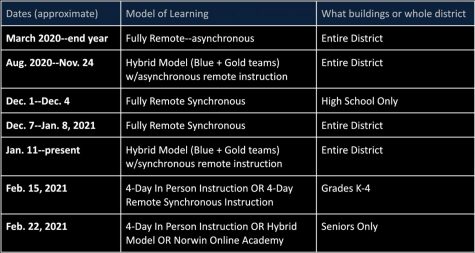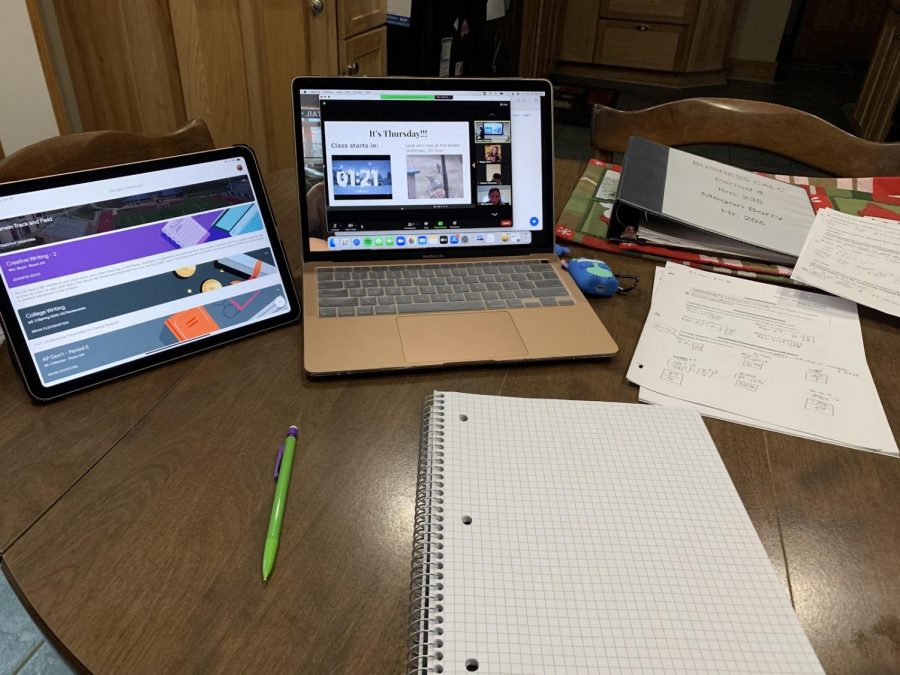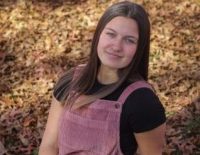I guess, 4th times a charm
February 3, 2021
Want to hear a crazy fact? The school model that we are currently in, is our 4th type of learning model since the COVID shutdown last March.
The first model was strictly asynchronous online in March of 2020. Most students were given all of their assignments for the week on Monday and students were expected to have their work done by 3:00 pm on Friday afternoon. Some students even had Zooms for some classes.
“I feel I learned more from the teacher over Zoom because they kept us focused and kept us involved,” said senior Cadin Anluf.
The next model was a hybrid model that began at the beginning of the 2020-21 school year this fall. The student body was split into a BLUEand GOLD group to help succeed in social distance. BLUE group goes to school on Monday and Tuesday, and did asynchronous (online-independent) work for the rest of the week. While the GOLD group is online in the beginning of the week and in school on Thursday and Friday. Many students, including senior Cory Johnson, preferred this learning model compared to the one in March.
“As a senior, asynchronous learning was much better. I only have to partake in 5 classes and 3 of them are electives,” said Johnson. “I feel that I was able to learn by actually having to read the text book and watch online videos. I also feel like I had gotten more work done.”
The next model was a fully online model in December due to spike in COVID cases in County and district. This model was strictly synchronous Zooms that were during the same time as the period as if we were in school.
The final school model that students are presently in, is a fully synchronous model. The different groups are still in effect but with a bit of a twist. The days each color coded group is online they have to Zoom into their classes on time, each day for each period.
“Synchronous learning in my opinion is hit or miss. Some days the teachers are very involved and will walk you through the lesson. But on other days you only log on to take attendance, and then you leave and do work on your own,” said Johnson. “I believe that it is not an effective way of learning, especially with all the distractions around us while at home.”
Another model will be offered to the elementary students only, starting on Feb. 15. This model will give students in grades K-4 the decision to do 4 days synchronous or go to school in person 4 days a week.
The transitioning from different models of learning has created quite a chaotic and unique school year. Although this school year has been extremely different than others, most classes were able to adapt and create an almost normal learning environment for the students. But the teachers strive to make this a normal school year, is not reaching the students.
In a student run poll on Instagram, about 72% of the students who took the poll would rather be in asynchronous learning. Unfortunately, since this school year is far from normal, at times student motivation is lost throughout the student body. Many students including senior Brooke Alexander feel that lack of motivation.
“There are no dances. No attending any type of sport events. No club activities,” said Alexander. “There is nothing to look forward to, so the motivation to go to school and do school work is lost.”
But here hopefully there is some good news. The school year is over half way through. With some hope and optimism, students could have a normal end of the school year.




